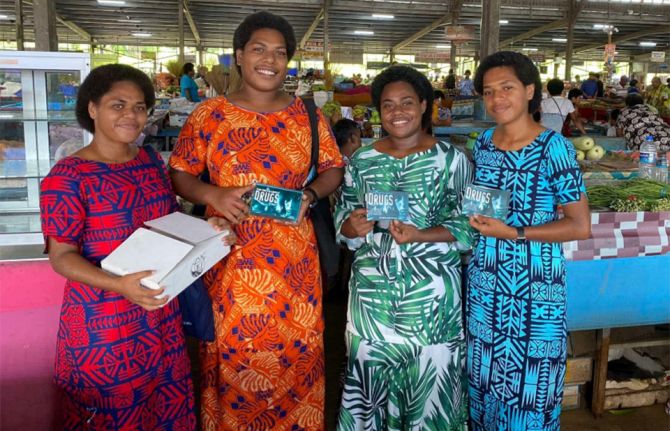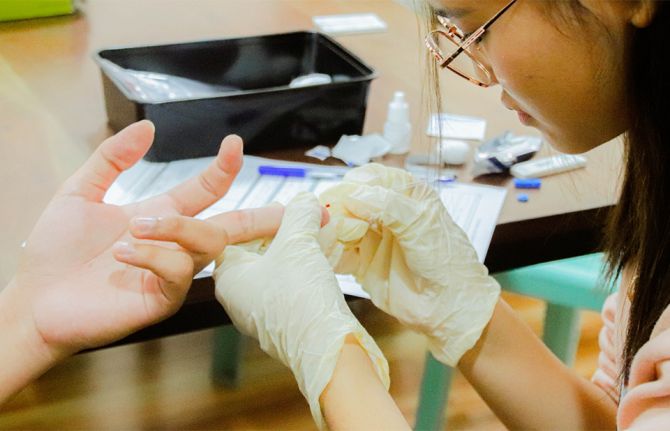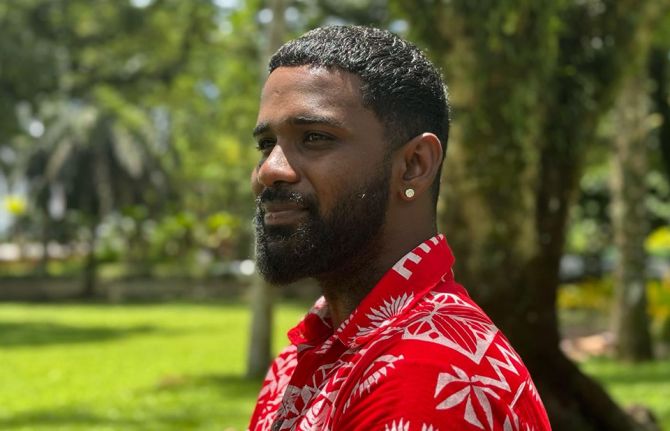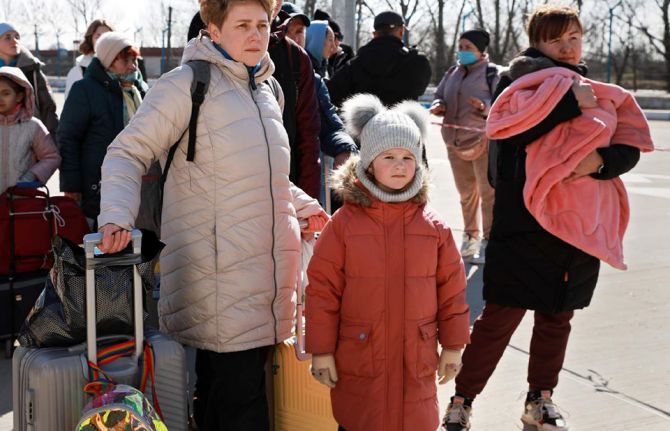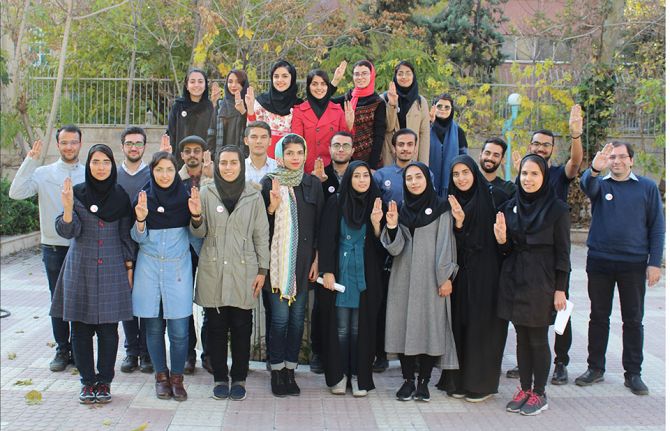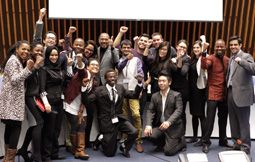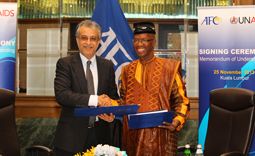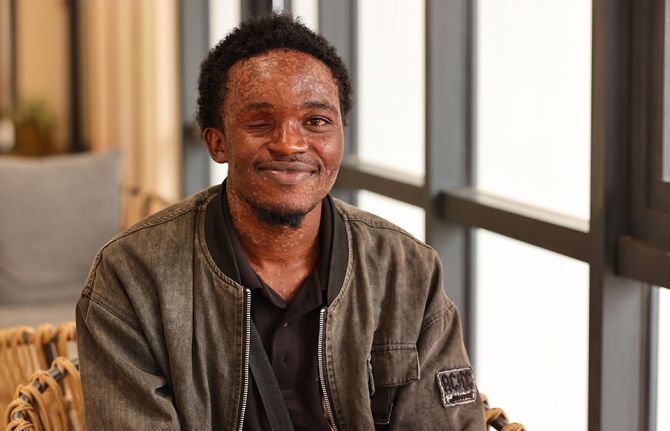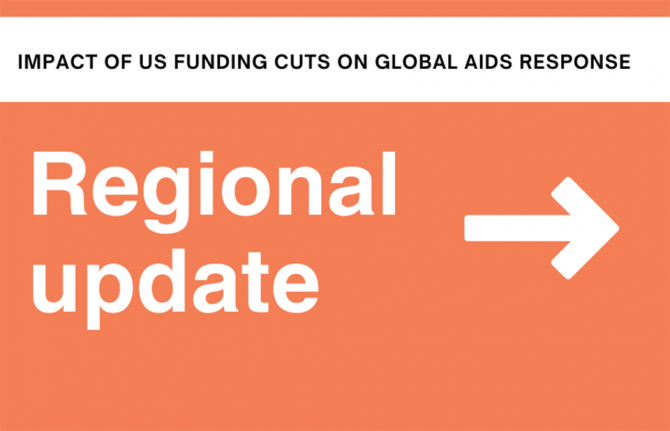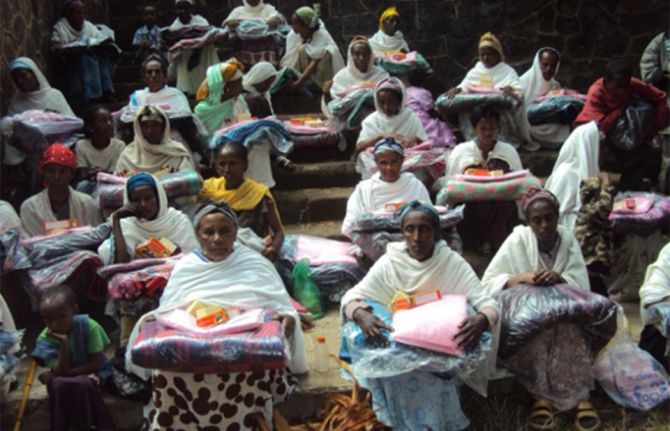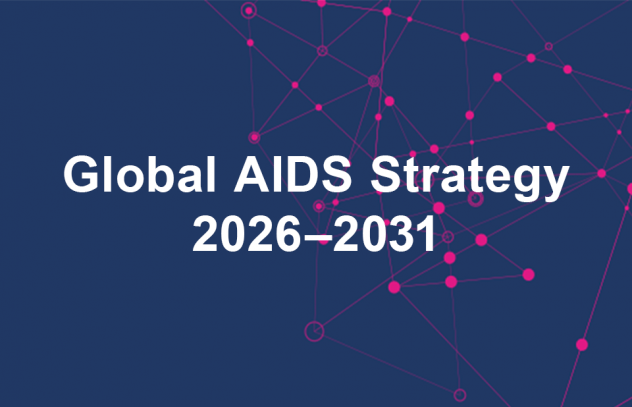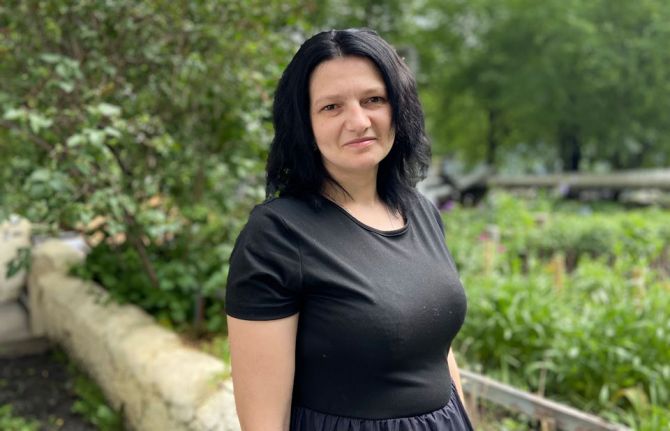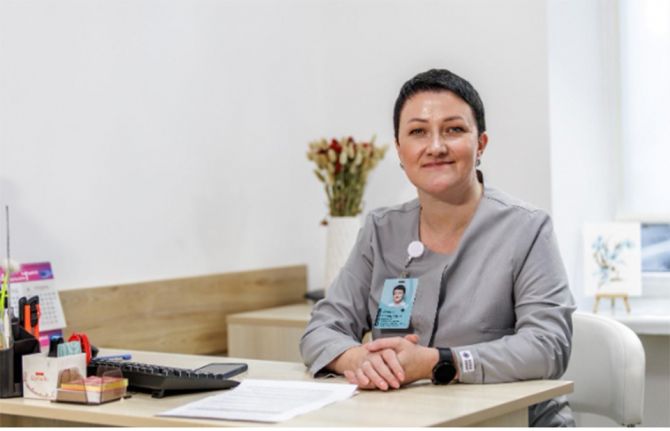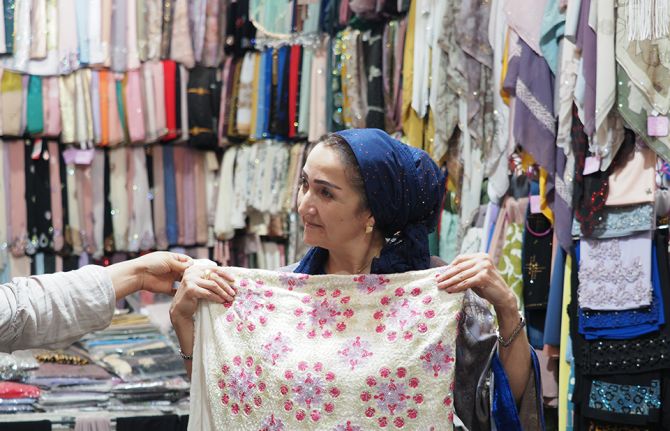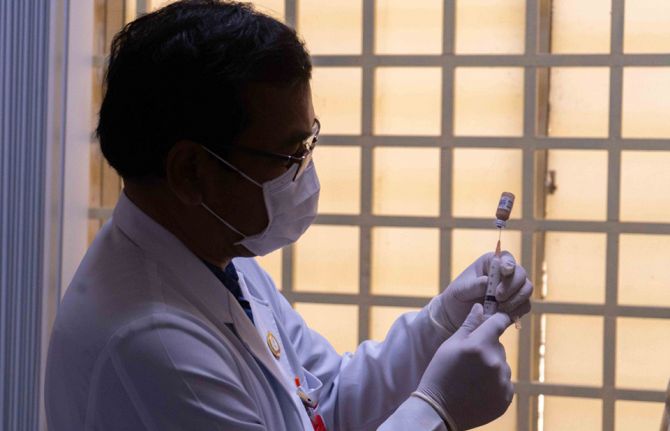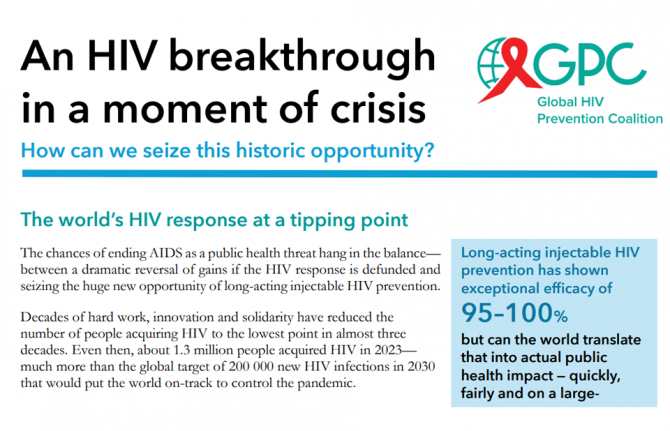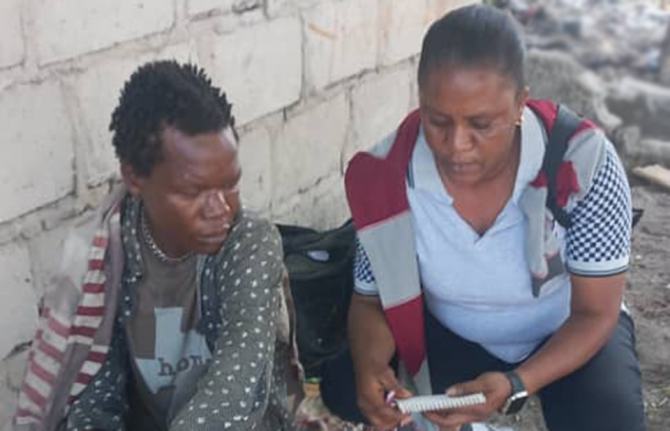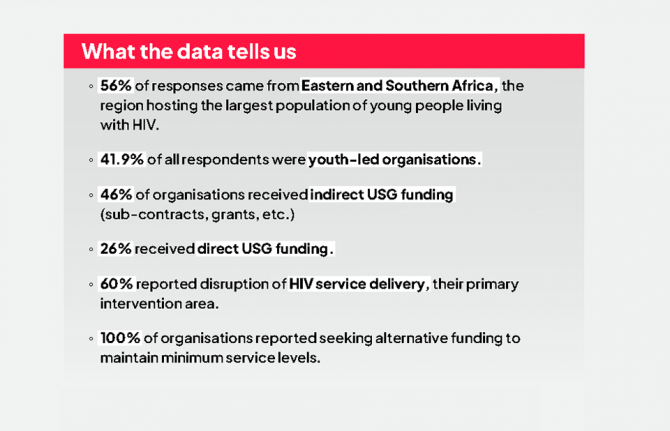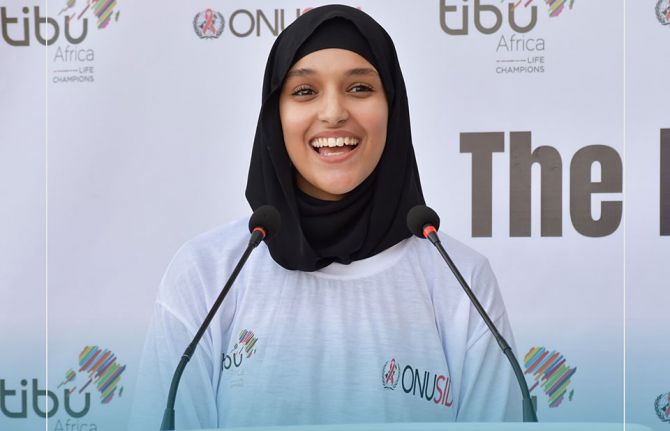
Feature Story
Engaging cities in the HIV response
10 August 2010
10 August 2010 10 August 2010
UNAIDS Executive Director, Mr Michel Sidibé, delivers a keynote speech on "HIV in Cities of the 21st Century” at the International Forum on Cities and Health, 9 August 2010, Shanghai, China Credit: UNAIDS
Approximately half of the world’s population lives in cities. By 2050, seven out of ten global citizens will be living in a “mega-city” of more than 10 million people. In an official visit this week to Shanghai—one of the world’s largest metropolises—UNAIDS Executive Director Michel Sidibé called attention to the central role that cities can play in the AIDS response.
“While it is clear that cities are important to the HIV response, they have not been sufficiently mobilized and supported to act,” said Mr Sidibé, addressing an audience of more than 100 health sector leaders and practitioners from across China. “I believe that it is time for this to change and for cities to take the lead in making HIV history.”
The rapid growth of cities has created conditions where HIV can thrive. Globally, it is estimated that as many as 50% of HIV-positive people live in cities. In some urban areas, the HIV epidemic is so pervasive that it is compares to national epidemics of entire countries.
Noting that city governments have administrative power and well-established systems for delivering social services, Mr Sidibé urged city authorities to mobilize all available resources to ensure universal access to HIV prevention, treatment, care and support. To that end, only a few cities, he said, have shown bold leadership and acted in a timely manner.
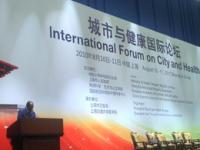
UNAIDS Executive Director, Mr Michel Sidibé, delivers a keynote speech on "HIV in Cities of the 21st Century” at the International Forum on Cities and Health, 9 August 2010, Shanghai, China Credit: UNAIDS
Efforts by the city of Bangkok to reduce HIV prevalence among sex workers provide one such success story. In collaboration with health providers, the police, entertainment industry owners, non-governmental organizations and sex workers, authorities in Bangkok launched a city-wide campaign in the early 1990s promoting 100% condom use. Over the course of 20 years, HIV prevalence among the city’s brothel-based sex workers has fallen significantly.
While in Shanghai, Mr Sidibé commended Chinese leaders on the country’s progress in scaling up methadone maintenance treatment and needle exchange programmes in large cities, which have been critical in reversing the HIV epidemic among injecting drug users. “I encourage China to continue to expand these programmes—particularly at the community level—and to reconsider whether drug detention centres are really effective as part of a national strategy to prevent HIV transmission,” he said.
Other cities facing burgeoning HIV epidemics among injecting drug users, such as Sydney, Toronto and Geneva, have implemented cost-effective harm reduction programmes, including needle exchange and opiate substitution therapy, stemming the tide of new HIV infections.
Mr Sidibé challenged China’s cities to be at the forefront of localized AIDS responses that address, in particular, the needs of populations at higher risk of HIV infection, such as men who have sex with men, migrant workers, sex workers and injecting drug users. He called on Shanghai to build on the momentum of Expo 2010, uniting and mobilizing mega-cities of the world to become HIV-free by 2015.
Right Hand Content
Speeches:
Keynote speech by UNAIDS Executive Director, Mr Michel Sidibé at the International Forum on Cities and Health, 10 August 2010, Shanghai, China(en | ch)
Multimedia:
View photo gallery of UNAIDS Executive Director official visit to China, August 2010

Feature Story
WHO online consultation on global health sector strategy for HIV
06 August 2010
06 August 2010 06 August 2010
The World Health Organization (WHO) has launched a web-based consultation to seek input on the development of the WHO Global Health Sector Strategy for HIV/AIDS, 2011-2015.
The Sixty-third Session of the World Health Assembly adopted a resolution requesting that the World Health Organization (WHO) Director-General develop a WHO HIV/AIDS Strategy for 2011-2015, through a broad consultative process.
You are invited to provide your feedback on the consultation materials found on the WHO web site. These materials will be available in Arabic, Chinese, English, French, Russian and Spanish.
Comments should be submitted by 31 August using this online form. Where possible, please submit your comments in English to facilitate the synthesis of all inputs.
The 2011-2015 strategy will:
- Build on the achievements and experiences of the "3 by 5" initiative and the five strategic directions of the WHO HIV/AIDS Universal Access Plan 2006-2010;
- Take into consideration the broad global HIV, health and development architecture, including the UNAIDS Strategy (under development) and UNAIDS Outcome Framework, and existing commitments to achieving Universal Access and the Millennium Development Goals;
- Identify existing and agreed global targets to motivate countries to plan for bold HIV responses through to 2015;
- Provide guidance to countries on how to prioritize their HIV and broader health investments;
- Provide a framework for concerted WHO action at the global, regional and country levels and across all relevant WHO departments.
WHO works in partnership with a broad range of constituencies, including Member States, civil society, donor and development agencies, non-governmental organizations, multilateral agencies (including the UN family), scientific and technical institutions and networks, and the private sector. WHO is committed to a consultation process that involves all key stakeholders and constituencies in the development of the Global Health Sector Strategy for HIV/AIDS, 2011-2015.
Related

Feature Story
Partnership for HIV prevention in Sri Lanka
03 August 2010
03 August 2010 03 August 2010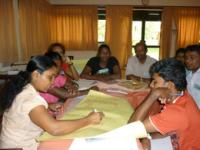 Field staff training for the size estimation study in Sri Lanka.
Field staff training for the size estimation study in Sri Lanka. Credit: Dr. Ajith Karawita
HIV prevalence in the general population of Sri Lanka is very low at 0.1%. However data indicates that people who buy and sell sex and men who have sex with men are at risk of HIV infection yet little is known regarding the size of these groups making it difficult to guide the country’s HIV prevention efforts.
To build a baseline of strategic information, the Joint UN Team on AIDS at the request of the National STI/AIDS Control Programme in Sri Lanka, supported the development of a mapping and size estimation methodology for key populations. The World Bank provided technical assistance and UNFPA and UNAIDS gave top-up funding to ensure that communities in four districts could use the methodology.
The study’s findings, published in May 2010 estimate between 35 000 to 47 000 sex workers and between 24 000 to 37 000 men have sex with men in Sri Lanka.
Partnership key for effective HIV prevention
A constructive new partnership has emerged from the process. Representatives of men who have sex with men and sex workers met regularly with senior government officials from the Police and the Ministry of Health to implement the public health programme.
For the first time in Sri Lanka a public health issue is being addressed by non-traditional stakeholders who have come together for a common cause—the prevention of HIV among key populations at higher risk.
Dr Palitha Mahipala, Additional Secretary – Ministry of Healthcare and Nutrition
“For the first time in Sri Lanka a public health issue is being addressed by non-traditional stakeholders who have come together for a common cause—the prevention of HIV among key populations at higher risk,” said Dr Palitha Mahipala, Additional Secretary – Ministry of Healthcare and Nutrition and chair of the steering committee created to guide implementation.
Community groups were briefed by a team who worked on similar exercises in Pakistan and India who ensured that the methodology was adapted for easy use in Sri Lanka.
“Community members received excellent training on planning of field work, data collection, data entry, analysis and basic knowledge on micro planning for prevention services for sex workers from the University of Manitoba,” said Chandra Kanthi Abeykoon, Project Coordinator Community Strength and Development Foundation.
Filling the evidence gaps
This process has been a critical first step in building effective prevention for key populations at higher risk here in Sri Lanka.
David Bridger, UNAIDS Country Coordinator
The mapping was first undertaken in Colombo and Anuradhapura where initial results suggested that the numbers of sexually active men who have sex with men and sex workers were much higher than previously thought. According to the study team, participants from the community organizations appreciated the value of understanding exactly where hotspots for sex work are to ensure that HIV prevention programmes reach people in need of services.
Guarding the confidentiality of participants was a key concern in the project. In order to safeguard identities it was agreed that only community groups had access to the data with street names and locations which is relevant for prevention outreach activities.
The mapping was extended to Batticaloa and Nuwara Eliya. The National STD/AIDS Control Programme has used the broader averaged data from three of the districts to feed into the national estimates process where the country has been able to produce an evidence-based national estimate for key populations at higher risk for the first time.
During the project, the study team faced some challenges where local authorities intervened and questioned the exercise as it concerned behaviors that are regulated by punitive laws: both homosexuality and sex work are illegal in Sri Lanka. Members of the study team from the Ministry of Health and community organizations travelled to the research sites to meet with district officials to discuss and agree on the goals of the exercise.
Building momentum
Building on the prevention partnership established, the Government and civil society successfully applied for a grant from round 9 of the Global Fund to Fight AIDS, TB and Malaria. The grant, approved in early 2010, will enable the mapping exercise to be extended across the country and be complemented with prevention outreach to these key populations as well as to people who inject drugs, in prison settings.
“This process has been a critical first step in building effective prevention for key populations at higher risk here in Sri Lanka,” said David Bridger, UNAIDS Country Coordinator.
“A comprehensive package of prevention for key populations at higher risk in of HIV infection in Sri Lanka is a solid way of ensuring that HIV will remain at low levels in this country,” he added.
However barriers to effective prevention still remain and will continue to affect the implementation of the Government’s HIV prevention programme for key populations at higher risk over the next 5 years. Laws that criminalize certain behaviour push populations at higher HIV risk underground and away from HIV prevention services will need to be raised and more openly discussed.
Related

Feature Story
African First Ladies and UNAIDS to work together for the elimination of mother-to-child transmission of HIV
03 August 2010
03 August 2010 03 August 2010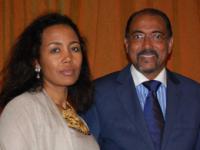
(from left) H.E Azeb Mesfin, First Lady of Ethiopia, Chair of OAFLA and Mr Michel Sidibé, UNAIDS Executive Director. 27 July 2010, African Union summit.
In its 8th General Assembly, members of the Organization of African First Ladies against HIV and AIDS (OAFLA) gathered in Kampala, Uganda, to deliberate on the theme of “Maternal and Child Health.” The First Ladies renewed their commitment to champion the well-being of African women and children in a Declaration presented at the end of the meeting.
In her welcome remarks, Mrs Janet Museveni—host of the General Assembly and First Lady of Uganda—expressed her gratitude to all partners who have supported the efforts of OAFLA across Africa since 2001. Sharing Ugandan success stories from the 1990s, she encouraged her fellow First Ladies to use their positions to accelerate the HIV response in their respective countries. “We, the First Ladies of Africa, are supremely positioned to contribute, and even spearhead, HIV prevention campaigns—this is how we will drastically reduce the escalating numbers of new HIV infections among our populations,” she said.
Mrs Azeb Mesfin, First Lady of Ethiopia and Chair of OAFLA, urged her fellow members of OAFLA to continue to use their roles to address HIV in collaboration with partners around the world.
“As African women and First Ladies, we have a tendency to downplay our strengths and achievements,” she said. “HIV in Africa is an African problem and we, as Africans, will work together to find the solution. This does not mean that we do not appreciate the generous support of our friends across the globe. It means that we will provide the leadership necessary to fight this epidemic.”
Speaking at the OAFLA General Assembly, UNAIDS Executive Director Mr Michel Sidibé congratulated African First Ladies for playing a leading role in saving mothers and preventing new HIV infections in children—a major concern for UNAIDS. “As First Ladies of Africa, you can be at the forefront of preventing mothers from dying and preventing babies from becoming needlessly infected with HIV.” He also lauded OAFLA’s “Save the Unborn Child” campaign, which has invigorated countries to push harder to reduce child mortality in Africa.
Mr Sidibé called on the First Ladies to encourage governments, communities, women’s groups, and the AIDS movement to support their efforts to save the lives of mothers and children in Africa. He announced that UNAIDS and the United States President’s Emergency Plan for AIDS Relief (PEPFAR) will grant US$ 300,000 to OAFLA to support the development of regional and national activities to prevent mother-to-child transmission of HIV and address barriers affecting the scale-up of essential services to eliminate pediatric AIDS.
Right Hand Content
Speeches:
Declaration of OAFLA in support of the “Maternal and child health and development in Africa” theme of the African Union
Opening remarks by the Hon. Janet K. Museveni, First Lady of Uganda and Minister of State for Karamoja Affairs
Speech by Hon. Azeb Mesfin, President of OAFLA, First Lady of Ethiopia
Speech by UNAIDS Executive Director Mr Michel Sidibé
Feature stories:
ICASA 2008: First Ladies of Africa speak out on stigma (04 December 2008)
African First Ladies meet on AIDS (04 February 2008)
African First Ladies determined to speed up AIDS response (04 July 2007)
External links:
Related

Feature Story
UN Secretary-General awards special commendation to UN Cares
30 July 2010
30 July 2010 30 July 2010
UN Cares
On 29 July 2010 UN Secretary-General Ban Ki-moon awarded a "special commendation" to UN Cares during the UN 21 Awards at UN Headquarters in New York.
UN Cares is an inter-agency programme designed to reduce the negative impact of HIV on the UN workplace by educating UN staff and families on HIV and provide support for staff living with HIV.
The programme is designed to help staff and families to access their rights defined in the 1991 United Nations HIV/AIDS Personnel Policy and in the ILO Code of Practice on HIV/AIDS and the World of Work and recognize their individual responsibilities related to HIV. The global programme was launched in May 2008.
Developed through interagency consultation between UNAIDS Cosponsors and other UN bodies, UN Cares is available to UN system personnel and their families in all entities and all duty stations.
UNAIDS plays a vital role in supporting UN Cares and the award highlights the great work of UNAIDS staff around the world in support of this groundbreaking programme that benefits thousands of UN employees and family members worldwide
Ms Jan Beagle, UNAIDS Deputy Executive Director, Management and External Relations
“This commendation by the Secretary-General acknowledges the outstanding global effort from UN colleagues worldwide and those who volunteer their time to disseminate UN Cares messages in the UN workplace,” said Ms Jan Beagle, UNAIDS Deputy Executive Director, Management and External Relations.
“UNAIDS plays a vital role in supporting UN Cares and the award highlights the great work of UNAIDS staff around the world in support of this groundbreaking programme that benefits thousands of UN employees and family members worldwide,” Ms Beagle added.
UN 21 Awards
The UN 21 Awards annual awards were established as part of the reform effort by the former Secretary-General Kofi Annan in 1996 to provide recognition to staff members for innovation, efficiency and excellence in the delivery of the Organization's programmes and services. Commendations are given for excellence and/or outstanding inter-agency coordination.
Related
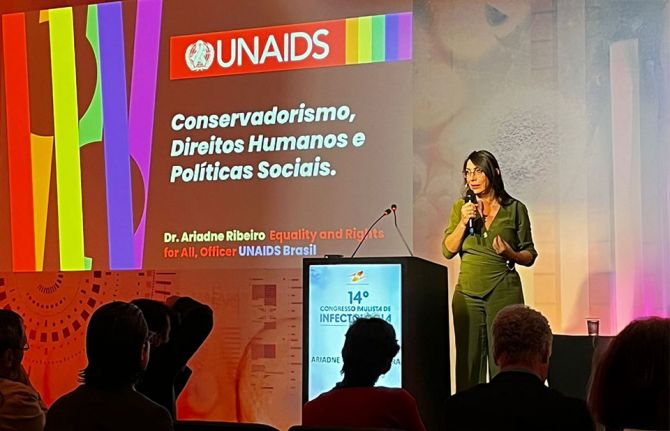 Upholding dignity for everyone: Ariadne Ribeiro Ferreira
Upholding dignity for everyone: Ariadne Ribeiro Ferreira

21 November 2024
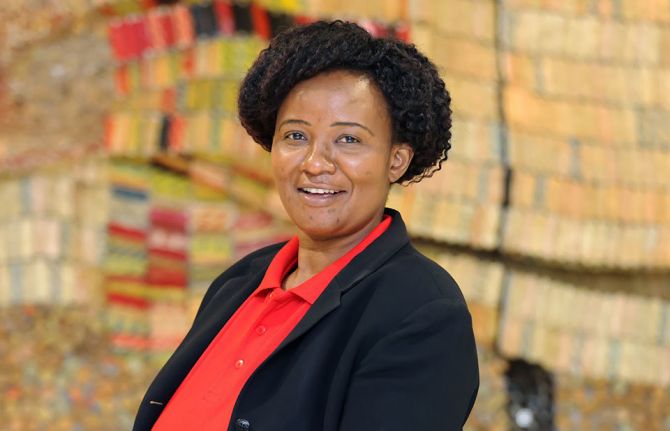 Evelyn Siula: A journey of strength and solidarity
Evelyn Siula: A journey of strength and solidarity
18 November 2024

Feature Story
UNAIDS calls better integration of HIV prevention and treatment in maternal, newborn and child health programmes in Ethiopia
30 July 2010
30 July 2010 30 July 2010
UNAIDS Executive Director Mr Michel Sidibé (left) met with H.E. Dr Tedros Adhanom Ghebreyesus, Minister of Health Ethiopia at the Ministry of Health, Addis Ababa, Wednesday 28 July 2010
The Executive Director of UNAIDS, Michel Sidibé paid a visit to Ethiopia to discuss ways of accelerating progress towards achieving universal access to HIV services and reaching the Millennium Development Goals in the country.
High on the agenda was exploring the progress and challenges Ethiopia is facing in preventing mother-to-child HIV transmission (PMTCT).
Mr Sidibé visited the HIV treatment centre and maternity ward at St Paul’s hospital in Addis Ababa where nutritional support is integrated with health service delivery for people living with HIV. While there, Mr Sidibé had an opportunity to participate in the “Mother Support Group Discussions,” a peer support group of HIV positive women who meet fortnightly for psychological support by sharing their experiences and exchanging views on a range of social issues including experiencing stigma, positive living, telling their partners about their HIV status, clinic attendance, and family planning.
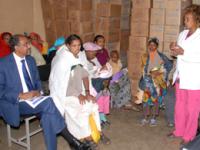
UNAIDS Executive Director Mr Michel Sidibé (left) listens to a discussion with PMTCT programme clients at Gulele sub city food distribution centre, Addis Ababa, Wednesday 28 July 2010.
On conclusion of his visit, Mr Sidibé met with the journalists to highlight the need for renewed commitment towards the virtual elimination of mother to child transmission of HIV and the need for innovative approaches to sustain the response.
Mr Sidibé praised the efforts being made by the government of Ethiopia towards eradicating mother-to-child HIV transmission and called on the leadership to intensify efforts to increase access to PMTCT services while addressing the factors undermining access to these services including gender inequality, stigma and discrimination and the insufficient involvement of the community.
Mr Sidibé also urged for enhanced integration of HIV prevention and treatment into maternal, newborn and child health programmes.
Earlier, the UNAIDS executive director had paid a visit to one of the HIV urban projects supported by the World Food Programme (WFP) which provide food and nutritional assistance to pregnant and lactating women living with HIV who are accessing PMTCT services. He met with a group of mothers who participate in this project and commended the initiative which supports lives of mothers and babies through the provision of food and nutritional support.
Related

Feature Story
NGO delegation to UNAIDS board seeks new members
28 July 2010
28 July 2010 28 July 2010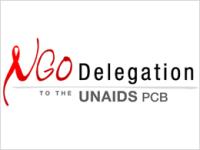 The Programme Coordinating Board (PCB) is the governing body of the Joint United Nations Programme on HIV/AIDS (UNAIDS) and is made up of Member States, the UNAIDS Cosponsors (the ten United Nations organizations that make up the joint programme), and nongovernmental organization (NGO) delegates.
The Programme Coordinating Board (PCB) is the governing body of the Joint United Nations Programme on HIV/AIDS (UNAIDS) and is made up of Member States, the UNAIDS Cosponsors (the ten United Nations organizations that make up the joint programme), and nongovernmental organization (NGO) delegates.The PCB NGO Delegates represent the perspectives of civil society, including people living with HIV, within UNAIDS policies and programming. NGO delegates actively seek input from their respective communities on key issues related to UNAIDS policies and programmes, and advocate with members states (governments) and Cosponsors for meaningful improvements in the implementation and evaluation of AIDS policies and programmes.
NGO Delegation vacancies
The NGO Delegation to the UNAIDS PCB has vacancies for two-year terms beginning 1 January 2011 and ending 31 December 2012, for the following positions:
- North America Main Delegate
- North America Alternate Delegate
- Latin America and the Caribbean Alternate Delegate
- Africa Alternate Delegate
- Asia and the Pacific Alternate Delegate
Where can I get more information?
For a complete description and online application in English, please visit the NGO Delegation to the UNAIDS PCB web site .
Deadline
Fill in the online application and submit all required documents by 16 August 2010, 18:00 Geneva Time.
You can contact the Communications Facility for additional information by emailing Natalie Siniora at pcbcf.nsiniora@gmail.com.

Feature Story
Vienna 2010 closes with a renewed commitment for AIDS + MDGs
23 July 2010
23 July 2010 23 July 2010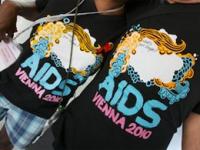
The XVIII International AIDS Conference ended in Vienna today after a week of intense dialogue involving 19,300 people from 193 countries engaged in the global AIDS response.
Delegates and organizers depart Vienna – where the conference opened 18 July under the theme of Rights Here, Right Now – with a renewed commitment to push for securing universal access to HIV prevention, care, treatment and support.
“Billions of people stand in solidarity with us in our drive for universal access. We must rally their support behind Michel Sidibé’s Prevention Revolution and Treatment 2.0 initiative and UNAIDS to ensure that world leaders do not turn their backs on their pledge to reach the goal of universal access,” said Dr. Julio Montaner, AIDS 2010 Chair, President of the International AIDS Society and Director of the B.C. Centre for Excellence in HIV/AIDS in Vancouver, Canada.
The conference saw a renewed commitment to HIV prevention, were treatment 2.0 outlines the effort to merge treatment with combination HIV prevention to ensure a cohesive and resource-maximizing AIDS response. Evidence was seen of tangible progress in HIV research and programme scale up however the AIDS response is facing an urgent need for increased resources, the protection of human rights, and broader use of scientifically sound prevention strategies.
Political, civil society and development leaders, policymakers, scientists and activists from around the world descended on Vienna from 18-23 July 2010 to engage in dialogue on the major issues facing the global response to HIV. The week-long programme featured 248 sessions covering science, community and leadership. The conference was supported by 770 volunteers from Vienna and elsewhere.
The Closing Session featured a video address by South African Archbishop Desmond Tutu, remarks by Rachel Ong, Chair of the Global Network of People Living with HIV, and Patricia Perez, Chair of the International Steering Committee of the International Community of Women Living with HIV/AIDS. Montaner and Incoming IAS President Elly Katabira, Professor of Medicine at Makerere University in Uganda, presented the first IAS Presidential Award to Jack Whitescarver of the U.S. National Institutes of Health and Katabira gave an inaugural address.
The International AIDS Conference is the world’s largest HIV forum. It is held every two years and organized by the International AIDS Society, together with a series of partners including UNAIDS. The next conference will be hosted by Washington DC, USA in July 2012 at the Walter E. Washington Convention Center.
Right Hand Content
Publications:
UNAIDS Outlook Report 2010 (pdf, 6 Mb)
UNAIDS Outcome Framework 2009-2011 (pdf, 388 Kb)
Related

Feature Story
Exploring combination prevention: the way forward
23 July 2010
23 July 2010 23 July 2010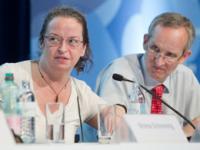
(from left) Ms Ruth Morgan Thomas, Global Coordinator for the Network of Sex Work Projects (NSWP); Dr Bernhard Schwartländer, Director of UNAIDS Department of Evidence, Strategy and Results. Credit: UNAIDS/Anne Rauchenberger
For every two people who start on HIV treatment, five are newly infected. With the need to focus on HIV prevention becoming ever more acute, how can those at risk of contracting HIV be targeted to produce impact? What can we scale up? How to bring coordination in interventions that complement each other? These are some of the key questions explored in a UNAIDS Satellite Session at the XVIII International AIDS Conference in Vienna.
Entitled Combination prevention in action: targeted approaches, the session highlighted the need to address prevention in a range of key populations, including sex workers and their clients, injecting drug users, men who have sex with men, populations in humanitarian crisis, and migrants.
Representatives from the UN system and civil society emphasised the importance of coordinated HIV prevention efforts and addressing gaps in the AIDS response at a country, regional and global level. They shared experiences and built on lessons learned in dealing with HIV in specific populations, discussing the opportunities and challenges of combination prevention.
Opening the discussions, Ms Purnima Mane, UNFPA’s Deputy Executive Director, explained that UNAIDS advocates a combination approach to HIV prevention which takes into account the realities of local epidemics. Combination prevention requires action on both immediate personal risks and on the underlying drivers of the epidemic. It means a multi-pronged strategy providing services and programmes for individuals as well as investment in structural interventions, such as legal reforms to outlaw discrimination against people living with HIV.

Satellite session: Combination prevention in action: targeted approaches. Credit: UNAIDS/Anne Rauchenberger
Chaired by Dr Bernhard Schwartländer, Director of UNAIDS Department of Evidence, Strategy and Results, the session attracted a broad range of speakers. These included Signe Rotberga, a UNODC Regional Project Coordinator who shared lessons about AIDS prevention and care among injecting drug users and in prison settings in the Baltic states.
HIV and sex work in humanitarian settings was the subject of the contribution from UNHCR’s Dr.Patterson Njogu, Senior Regional Global HIV/AIDS Coordinator for East and Horn of Africa. ILO’s Richard Howard, HIV/AIDS Regional Specialist for Asia and the Pacific, spoke about reaching sex workers clients through workplace interventions. Ying-Ru Lo from WHO explained ongoing processes for the development of global guidance tools on prevention and treatment of HIV among most at risk populations.
Ruth Morgan Thomas for the Global Coordinator for the Network of Sex Work Projects (NSWP) and Shona Schonning from the Eurasian Harm Reduction Network (EHRN) gave insightful perspective of civil society on the different interventions.
Coming from myriad countries and settings, the participants shared a common goal: to reinforce the importance of targeted combination prevention that addresses the needs of the individual and promotes the creation of a safe and supportive environment based on human rights, protection and reduction of vulnerability.
Right Hand Content
Publications:
UNAIDS Outlook Report 2010 (pdf, 6 Mb)
UNAIDS Outcome Framework 2009-2011 (pdf, 388 Kb)

Feature Story
Y-PEER: Media helping empower young people to protect themselves from HIV
22 July 2010
22 July 2010 22 July 2010
Y-PEER event at AIDS 2010, 23 July 2010. Credit: UNAIDS/Heimo Aga
Harnessing the power of the mass media and new technologies to reach young people with information about HIV and reproductive health was high on the agenda at the XVIII International AIDS conference yesterday during a series of events sponsored by Y-PEER, a youth initiative pioneered by the United Nations Population Fund (UNFPA).
According to UNFPA a youth-centred approach, such as Y-PEER, is critical to genuine engagement for change.“If we want to engage young people on health and lifestyle issues that affect them, we need to be where they are, sharing information through platforms they are connecting to every day,” said Purnima Mane, UNFPA Deputy Executive Director (Programmes).
“Run by youth for youth, Y-Peer continues to grab hold of the latest trends in entertainment and social media through innovative partnerships to promote health and prevent HIV infection.”
In an innovative session, Using Edutainment for Social and Behaviour Change, one of Hollywood’s top writers and producers, Zoanne Clack of the award-winning US series Grey’s Anatomy, joined experts, such as Colin Dixon of Dance4Life, AIDS activists and Y-PEER ambassadors to discuss how HIV is dealt with in the entertainment media.
 Y-PEER phone app launched at AIDS2010, 23 July 2010. Credit: UNAIDS/Heimo Aga
Y-PEER phone app launched at AIDS2010, 23 July 2010. Credit: UNAIDS/Heimo AgaY-PEER is partnering with the Hollywood Health Society (HHS), which was represented by its director, Sandra de Castro Buffington, during the event. HHS, based at the University of Southern California, aims to provide writers and producers with accurate information for health storylines. Y-PEER works with HHS to try to identify similar models that can be easily replicated in other regions with the aim of sensitising the film industry and to encourage featuring HIV in popular programmes.
The session explored how education-entertainment, or ‘edutainment’, can bring issues around sexual and reproductive health, sexuality and HIV alive for a young audience, and how this can contribute to them making informed decisions in this critical area, helping them better protect themselves against the virus and reducing their vulnerability. Empowering young people to protect themselves from HIV is one of the ten priority areas in the UNAIDS Outcome Framework (2009-11).
Recognising the role that celebrities can play in using their influence to highlight issues and change attitudes, beliefs and behaviour, a number of stars who are also Y-PEER ambassadors attended the session as guest speakers. These included Hollywood resident actor and activist Sammy Sheikh (who appeared in the series ‘24’, United States of Tara and LOST) and singers Daniela Dimitrovska (Macedonia), Lotfi (Tunisia) and Ana Stanic (Serbia).
Last night also saw the launch of Y-PEER knowledge applications for smart phones. Building on the Y-PEER programme, this new ‘app’ is intended to test young people’s skills and knowledge surrounding adolescent sexual and reproductive health. It contains more than 500 questions with four different types of quiz play focussing on eight topics, such as HIV, gender and sexuality and drug use. As well as testing their knowledge, users can learn more about Y-PEER activities and compare their scores with other players. Y-PEER has thousands of members in 48 countries around the globe in a movement which builds capacity and mobilises young people to participate in the national and global response. Members work to highlight issues around sexual and reproductive health and rights, seeking to empower young people, especially the most vulnerable, to make informed choices.
Right Hand content
Cosponsors:
United Nations Population Fund
Partners:
Publications:
UNAIDS Outlook Report 2010 (pdf, 6 Mb)
UNAIDS Outcome Framework 2009-2011 (pdf, 388 Kb)
Related
 “Who will protect our young people?”
“Who will protect our young people?”

02 June 2025

